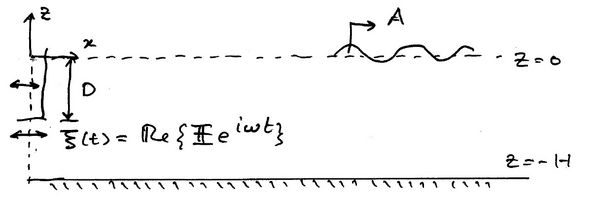Wavemaker Theory
Introduction
We will derive the potential in a two-dimensional wavetank due the motion of the wavemaker. The method is based on the Eigenfunction Matching Method. A paddle is undergoing small amplitude horizontal oscillations with displacement
where [math]\displaystyle{ f(z) }[/math] is assumed known. Since the time [math]\displaystyle{ t=0 }[/math] is arbitrary we can assume that [math]\displaystyle{ f(z) }[/math] is real but this is not necessary. Because the oscillations are small the linear equations apply (which will be given formally below). This excitation creates plane progressive waves with amplitude [math]\displaystyle{ A \, }[/math] down the tank. The principal objective of wavemaker theory is to determine [math]\displaystyle{ A \, }[/math] as a function of [math]\displaystyle{ \omega, f(z) \, }[/math] and [math]\displaystyle{ h \, }[/math]. Time-dependent wavemaker theories can also be developed.
Expansion of the solution
In general, the wavemaker displacement at [math]\displaystyle{ x=0\, }[/math] may be written in the form
where [math]\displaystyle{ f(z) \, }[/math] is a known function of [math]\displaystyle{ z \, }[/math]. The standard linear equations apply. Let the total velocity potential be
.
This gives us a Frequency Domain Problem. The water is assumed to have constant finite depth [math]\displaystyle{ h }[/math] and the [math]\displaystyle{ z }[/math]-direction points vertically upward with the water surface at [math]\displaystyle{ z=0 }[/math] and the sea floor at [math]\displaystyle{ z=-h }[/math]. The boundary value problem can therefore be expressed as
[math]\displaystyle{ \Delta\phi=0, \,\, -h\lt z\lt 0, }[/math]
[math]\displaystyle{ \phi_{z}=0, \,\, z=-h, }[/math]
[math]\displaystyle{ \left. \partial_x\phi \right|_{x=0} = \partial_t \xi = f(z). }[/math]
We must also apply the Sommerfeld Radiation Condition as [math]\displaystyle{ x\rightarrow\infty }[/math]. This essentially implies that the only wave at infinity is propagating away.
Separation of variables
We now separate variables and write the potential as
[math]\displaystyle{ \phi(x,z)=\zeta(z)\rho(x) }[/math]
Applying Laplace's equation we obtain
[math]\displaystyle{ \zeta_{zz}+k^{2}\zeta=0. }[/math]
We then use the boundary condition at [math]\displaystyle{ z=-h }[/math] to write
[math]\displaystyle{ \zeta=\cos k(z+h) }[/math]
The boundary condition at the free surface ([math]\displaystyle{ z=0 }[/math]) is
which is the Dispersion Relation for a Free Surface We denote the positive imaginary solution of this equation by [math]\displaystyle{ k_{0} }[/math] and the positive real solutions by [math]\displaystyle{ k_{m} }[/math], [math]\displaystyle{ m\geq1 }[/math]. We define
[math]\displaystyle{ \phi_{m}\left( z\right) =\frac{\cos k_{m}(z+h)}{\cos k_{m}h},\quad m\geq0 }[/math]
as the vertical eigenfunction of the potential in the open water region. From Sturm-Liouville theory the vertical eigenfunctions are orthogonal. They can be normalised to be orthonormal, but this has no advantages for a numerical implementation. It can be shown that
[math]\displaystyle{ \int\nolimits_{-h}^{0}\phi_{m}(z)\phi_{n}(z) d z=A_{n}\delta_{mn} }[/math]
where
[math]\displaystyle{ A_{n}=\frac{1}{2}\left( \frac{\cos k_{n}h\sin k_{m}h+k_{n}h}{k_{n}\cos ^{2}k_{n}h}\right) }[/math]
and
Expansion in Eigenfunctions
The wavemaker velocity potential [math]\displaystyle{ \phi }[/math] can be expressed simply in terms of eigenfunctions
and we can solve for the coefficients by matching at [math]\displaystyle{ x=0 }[/math]
It follows that
Far Field Wave
One of the primary objecives of wavemaker theory is to determine the far-field wave amplitude [math]\displaystyle{ A \, }[/math] ) in terms of [math]\displaystyle{ f(z) }[/math]. The far-field wave component representing progagating waves is given by:
We therefore obtain the complex amplitude of the propagating wave at infinity, namely modulus and phase, in terms of the wave maker displacement [math]\displaystyle{ f(z) }[/math].
For what type of [math]\displaystyle{ f(z) }[/math] are the non-wavelike modes zero? It is easy to verify by virtue of orthogonality that
Unfortunately this is not a "practical" displacement since [math]\displaystyle{ \phi_0 (z) \, }[/math] depends on [math]\displaystyle{ \omega\, }[/math]. So one would need to build a flexible paddle.
Matlab Code
A program to calculate the coefficients for the wave maker problems can be found here wavemaker.m
This article is based on the MIT open course notes and the original article can be found here
Ocean Wave Interaction with Ships and Offshore Energy Systems
